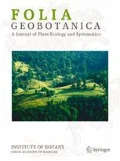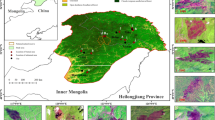Abstract
We tested the prediction that forest habitat types with relatively high productivity are not only relatively low in species richness but are also regionally uncommon. This relationship was supported by an analysis of data from 146 forest communities in southern Ontario, Canada. Potential forest habitat productivity was determined based on a classification scheme developed for the Canadian Land Inventory (CLI) project. Vascular plant species richness approximated a unimodal distribution across forest productivity classes with the lowest mean species richness recorded for the two most productive classes. The contemporary regional commonness of forest habitat productivity classes were also displayed as a unimodal frequency distribution. Hence, mean species richness per CLI class was positively correlated with the regional area of land encompassing each of these productivity classes and this relationship was increasingly significant at increasingly larger spatial scales of regional CLI class land areas. These results are consistent with the species pool hypothesis, which postulates that species richness is relatively low in highly productive habitats because such habitats have been relatively uncommon in both space and time and hence, have had relatively little historical opportunity for the origination of adapted species.
Similar content being viewed by others
References
Aarssen L.W. (2001): On correlations and causations between productivity and species richness in vegetation: predictions from habitat attributes.Basic Appl. Ecol. 2: 105–114.
Aarssen L.W. &Schamp B.S. (2002): Predicting distributions of species richness and species size in regional floras: Applying the species pool hypothesis to the habitat templet model.Perspect. Pl. Ecol. Evol. Syst. 5: 3–12.
Bolen E.G. (1998):Ecology of North America. John Wiley and Sons, Inc., New York.
Brown S.L. &Schroeder P.E. (1999): Spatial patterns of above-ground production and mortality of woody biomass for eastern U.S. forests.Ecol. Appl. 9: 968–980.
Currie D.J. &Paquin V. (1987): Large-scale biogeographical patterns of species richness of trees.Nature 329: 326–327.
Department of Regional Economic Expansion (1970):The Canada land inventory: land capability classification for forestry. Report No. 4, Queen’s Printer for Canada, Ottawa.
Environment Canada (1965):The Canada land inventory: objectives, scope and organization. Report No. 1, Queen’s Printer for Canada, Ottawa.
Gleason H.A. &Cronquist A. (1991):Manual of the vascular plants of northeastern United States and adjacent Canada. The New York Botanical Garden, New York.
Gower S.T., McMurtrie R.E. &Murty D. (1996): Aboveground net primary production decline with stand age: potential causes.Trends Ecol. Evol. 11: 378–382.
Grace J.B. (1999): The factors controlling species density in herbaceous plant communities: an assessment.Perspect. Pl. Ecol. Evol. Syst. 2: 1–28.
Grime J.P. (1979):Plant strategies and vegetation processes. Wiley & Sons, Chichester.
Hansen A.J., Rotella J.J., Kraska M.P.V. &Brown D. (2000): Spatial patterns of primary productivity in Greater Yellowstone Ecosystem.Landscape Ecol. 15: 505–522.
Hills G.A. (1957):A ready reference to the description of the land of Ontario and its productivity: a compendium of maps, charts, tables and brief comments. Division of research, Ontario department of lands and forests, Maple.
Huston M.A. (1979): A general hypothesis of species diversity.Amer. Naturalist 113: 81–101.
Huston M.A. (1994):Biological diversity: the coexistence of species on changing landscapes. Cambridge University Press, New York.
Huston M.A. (1999): Local processes and regional patterns: appropriate scales for understanding variation in the diversity of plants and animals.Oikos 86: 3393–3401.
Lee H., Bakowsky W., Riley J., Bowles J., Puddister M., Uhlig P. &McMurray S. (1998):Ecological land classification for southern Ontario: first approximation and its application. Ontario Ministry of Natural Resources, North Bay.
Mackey B. G., McKenney D.W., Yang Y., McMahon J.P. &Hutchinson M.F. (1996): Site regions revisited: a climatic analysis of Hills’ site regions for the province of Ontario using a parametric method.Canad. J. Forest Res. 26: 333–354.
Mittelbach G., Steiner C., Scheiner S., Gross K., Reynolds H., Waide R., Willig M., Dodson S. &Gough L. (2001): What is the observed relationship between species richness and productivity?Ecology 82: 2381–2396.
Ontario Ministry of Agriculture and Food (1977):Ontario soils: physical, chemical and biological properties and soil management practices. Publication No. 492, University of Guelph, Guelph.
Schamp B.S., Laird R.A. &Aarssen L.W. (2002): Fewer species because of uncommon habitat? Testing the species pool hypothesis for low plant species richness in highly productive habitats.Oikos 97: 145–151.
Taylor D.R., Aarssen L.W. &Loehle C. (1990): On the relationship between r/K selection and environmental carrying capacity: a new habitat templet for plant life history strategies.Oikos 58: 239–250.
Tilman D. (1982):Resource competition and community structure. Princeton University Press, New Jersey.
Waide R.B., Willig M.R., Steiner C.F., Mittelbach G., Gough L., Dodson S.I., Juday G.P. &Parmenter R. (1999): The relationship between productivity and species richness.Annual Rev. Ecol. Syst. 30: 257–300.
Author information
Authors and Affiliations
Corresponding author
Rights and permissions
About this article
Cite this article
Schamp, B.S., Aarssen, L.W. & Lee, H. Local plant species richness increases with regional habitat commonness across a gradient of forest productivity. Folia Geobot 38, 273–280 (2003). https://doi.org/10.1007/BF02803199
Received:
Revised:
Accepted:
Issue Date:
DOI: https://doi.org/10.1007/BF02803199




